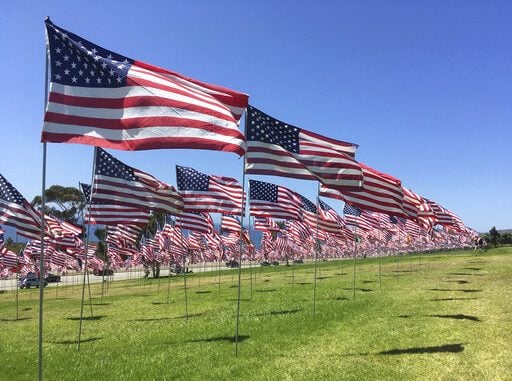
 On Sept. 10, 2001, exactly one day before the phrase “ground zero” came to mean the unthinkable, the unbearable, Amherst professor Jennie Traschen went on record calling the American flag a symbol of “terrorism and death and fear and destruction and oppression.” With that one statement, Traschen foretold how the radical left would respond to 9/11 — to the terrorism, death, fear and destruction that would transfix our nation the very next day.
On Sept. 10, 2001, exactly one day before the phrase “ground zero” came to mean the unthinkable, the unbearable, Amherst professor Jennie Traschen went on record calling the American flag a symbol of “terrorism and death and fear and destruction and oppression.” With that one statement, Traschen foretold how the radical left would respond to 9/11 — to the terrorism, death, fear and destruction that would transfix our nation the very next day.
By late afternoon on Sept. 11, University of Texas professor Robert Jensen had composed an op-ed calling the jihadists’ suicide mission “no more despicable than the massive acts of terrorism … the United State has committed.” Closer to home, UNC Chapel Hill professor Gerald Horne declared that “the bill has come due, the time of easy credit is up. It is time to pay.”
Osama Bin Laden himself had once declared, “We believe the worst thieves in the world today and the worst terrorists are the Americans.” That comment had come in bin Laden’s 1998 interview with ABC News, and three years later the radical left would seem to agree.
The backlash against our bin Laden sympathizers was swift and resounding, and for a time those aberrant voices were eclipsed by images of heroism at ground zero — and by the real experts on the history of jihad.
But in the space of two hours on Sept. 11, my role in the classroom had shifted from discussing “Othello” to facing students whose only question was: “Why do they hate us?” — and I made it my mission to study for answers.
My other challenge involved persuading a young Saudi woman to show up for class on Sept. 12. I had arranged to meet Norah outside our classroom so we could walk in together, and the scene that followed is indelible. I had promised there’d be no scowling in my class but never guessed that when Norah appeared, murmuring “I’m so sorry, I’m so sorry,” 19 young women would crowd around her, assuring her that no one would connect her to the carnage they’d witnessed on live TV. I still remember my students’ gesture as the moment that confirmed my faith in American decency.
In the weeks that followed, when students learned that to fly an American flag might invite charges of “jingoism,” they asked if I saw our flag as a symbol of arrogance and aggression. By that time, I had read Bernard Lewis’s new history “What Went Wrong” and knew a bit about Eastern contempt for Western prosperity but did not say out loud that the greater mystery concerned the sometime Western contempt for Western prosperity — and the American flag.
On the first anniversary of 9/11, I clipped a New York Times editorial I wish had been written in the immediate aftermath of that gruesome day. In a column titled “Moral Lessons of 9/11,” Thomas Friedman quoted a directive by journalist Larry Miller: “Listen carefully: We’re good, they’re evil — nothing is relative. Say it with me now and free yourselves. You see, folks, saying ‘We’re good’ doesn’t mean ‘We’re perfect.’… The plain fact is that our country has, with all our mistakes and blunders, always been and always will be the greatest beacon of freedom, charity, opportunity, and affection in history. If you need proof, open all the borders on Earth and see what happens. In about half a day, the entire world would be a ghost town, and the United States would look like one giant line to see ‘The Producers.’ … So here’s what I resolve: To never forget our murdered brothers and sisters. To never let the relativists get away with their immoral thinking. After all, no matter what your daughter’s political science professor says, we didn’t start this.”
Perhaps in response to Miller’s directive, in 2003, the Young America’s Foundation launched the 9/11: Never Forget Project, which each year provides resources to schools that wish to commemorate 9/11 by mounting displays of 2,977 flags, one for each victim the jihadists claimed on that other Date Which Will Live in Infamy.
Today’s displays will have a special meaning for college freshmen who also turned 18 this year. I hope they’ve seen footage of their counterparts in Hong Kong waving the Stars and Stripes and calling on us to “liberate” their Chinese-ruled city. And I hope that all Americans are grateful that Old Glory is still a beacon of hope for beleaguered subjects who are struggling to gain their freedom.
Just picture a patriot, hunched over her laptop, tapping out the tenets of a steadfast faith.



